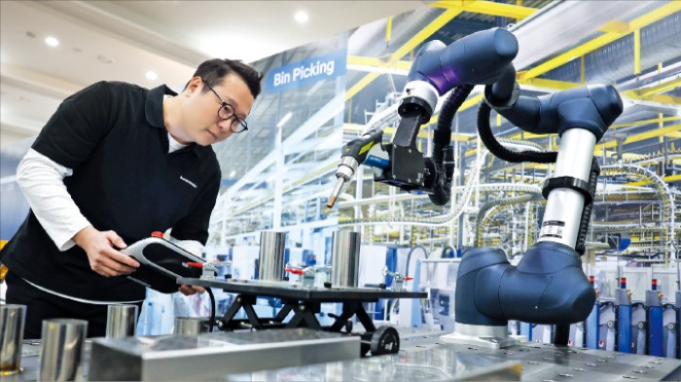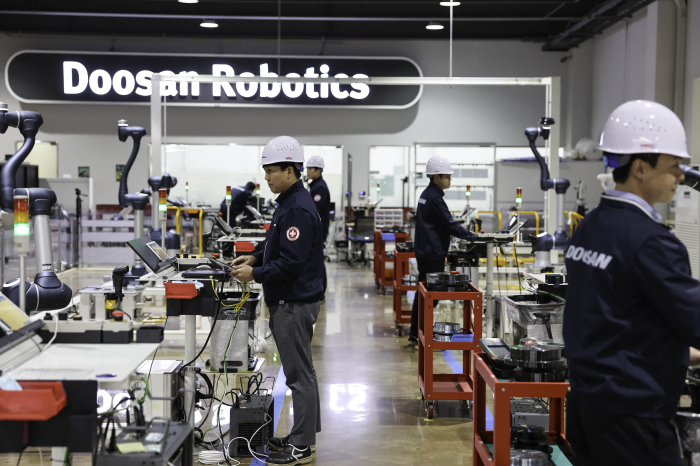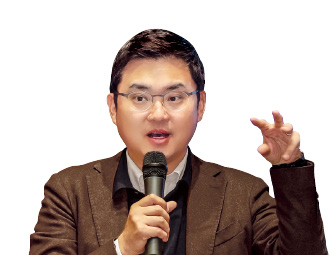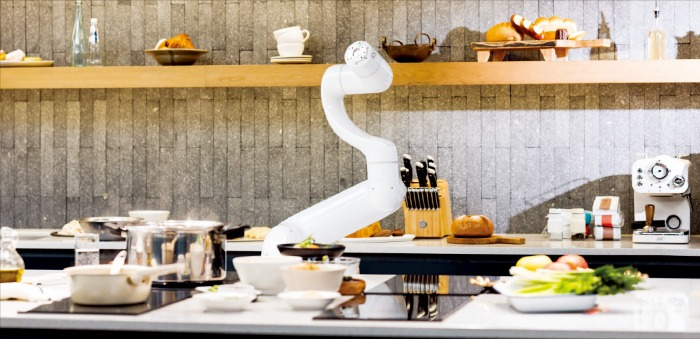Doosan Robotics eyes top spot in cobot market after Oct IPO
It is mulling M&As of autonomous logistics robot companies
By Dec 08, 2023 (Gmt+09:00)
LG Chem to sell water filter business to Glenwood PE for $692 million


Kyobo Life poised to buy Japan’s SBI Group-owned savings bank


KT&G eyes overseas M&A after rejecting activist fund's offer


StockX in merger talks with Naver’s online reseller Kream


Mirae Asset to be named Korea Post’s core real estate fund operator



SUWON – South Korea’s Doosan Robotics Inc. is aiming for the top spot in the collaborative robot market excluding China, zooming in on the US and Europe suffering from high labor costs, its chief executive said.
Buoyed by its share price more than tripling since the initial public offering on Oct. 5, Doosan Robotics plans to double the manufacturing capacity to about 4,000 units at its factory in Suwon, Gyeonggi Province. Currently, it churns out 2,200 robots a year at the facility.
For the capacity expansion, it earmarked 10 billion won ($7.6 million), with a plan to increase its product lineup from the current 13 to 17 by 2026.
As a fourth player in the ex-China collaborative robot market, it has been rapidly narrowing the gap with bigger rivals: Denmark’s Universal Robots, Japan’s Fanuc and Taiwan’s Techman Robot.

At the Suwon plant on Dec. 5, Doosan Robotics unveiled collaborative robot solutions that can be used at feeding facilities, as well as for laparoscopic surgery assistance, airport baggage handling, laser welding and bin picking, or picking up parts from a container.
The Doosan Group arm plans to introduce collaborative robots, or robots that work alongside people, to other various areas including the logistics sector.
To do so, it is considering mergers and acquisitions (M&As) of autonomous logistics robot companies, said William Ryu, chief executive of Doosan Robotics.
Last month, it installed four collaborative robots at a middle school cafeteria in Seoul. This marked the first time for the robots to be installed at a school in the country.
Doosan's robots have recently undergone tests for the capability of airport baggage handling at Schiphol Airport in the Netherlands.
SOLUTION PACKAGES
“Collaborative robots sell for at least 30 million won per unit, but if sold as a solution package, their price rises to 100 million won,” said Ryu, also known by his Korean name of Junghoon Ryu.

Collaborative robot solutions refer to standardized programs to task robots with jobs.
“Solution packages will likely account for 40% of our sales within three years from the current 10%,” he told reporters.
The company expects to turn a profit next year and post 264.2 billion won in sales with an operating profit margin of 21% in 2025.
Its share price has more than tripled to 87,600 won as of Friday morning, compared with its IPO price of 26,000 won.

Next year, Doosan Robotics will install nine new automation cell facilities at its factory in Suwon to bring the time needed to manufacture one collaborative robot module down to 37 minutes. It now takes one hour to manually manufacture one such robot.
“Demand for collaborative robots will grow rapidly in North America and Western Europe, where labor costs remain high,” Ryu said. “The robot penetration rate in these markets was 2% last year, so there is a lot of room for expansion.”
After establishing a subsidiary in Texas in 2022, Doosan will set up a unit in Germany in 2024.
Write to Hyung-Kyu Kim at khk@hankyung.com
Yeonhee Kim edited this article.
-
 IPOsEcoPro Materials, Doosan Robotics heat up Korean IPO market
IPOsEcoPro Materials, Doosan Robotics heat up Korean IPO marketDec 06, 2023 (Gmt+09:00)
3 Min read -
 RoboticsDoosan Robotics launches collaborative robot SW platform
RoboticsDoosan Robotics launches collaborative robot SW platformOct 10, 2023 (Gmt+09:00)
1 Min read -
 Mergers & AcquisitionsDoosan Robotics looks for M&A targets post-IPO: CEO
Mergers & AcquisitionsDoosan Robotics looks for M&A targets post-IPO: CEOOct 04, 2023 (Gmt+09:00)
3 Min read -
 IPOsDoosan Robotics attracts $24.8 billion from retail investors in IPO deposits
IPOsDoosan Robotics attracts $24.8 billion from retail investors in IPO depositsSep 22, 2023 (Gmt+09:00)
3 Min read -
 Artificial intelligenceDoosan Robotics to develop GPT-based collaborative robots
Artificial intelligenceDoosan Robotics to develop GPT-based collaborative robotsAug 24, 2023 (Gmt+09:00)
2 Min read -
 RoboticsDoosan Robotics to expand smart factory deployment using cobot
RoboticsDoosan Robotics to expand smart factory deployment using cobotJul 11, 2023 (Gmt+09:00)
1 Min read -
 RoboticsDoosan Robotics launches collaborative robot dedicated to F&B
RoboticsDoosan Robotics launches collaborative robot dedicated to F&BApr 17, 2023 (Gmt+09:00)
1 Min read -
 RoboticsDoosan Robotics signs medical robot MOU with Chinese company
RoboticsDoosan Robotics signs medical robot MOU with Chinese companyMar 21, 2023 (Gmt+09:00)
1 Min read -



